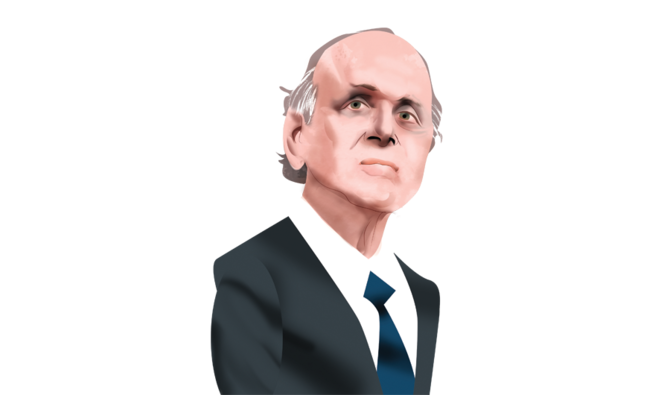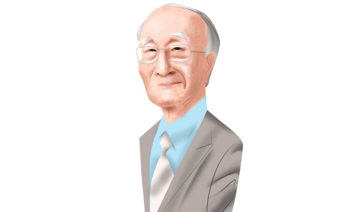The world does not stand still, but that just makes it more interesting, said Daniel Yergin in the VIP room at the Russian Energy Week forum in Moscow last week, and it seemed an appropriate metaphor for the career and lifestyle of the 72-year-old doyen of the global energy industry.
Yergin was ubiquitous at the Moscow event — one moment orchestrating a 10-man panel of energy big hitters under the bright lights of the plenary stage, the next posing happily for selfies with admirers, before heading off to private meetings with the most important policymakers in the energy world.
He has devoted his life to understanding the energy industry — not just as a business activity but as a force that affects the lives of everyone on the planet — and explaining it to the rest of the world.
An academic and journalist by training, he is probably best known for his 1991 book “The Prize: The Epic Quest for Oil, Money, and Power” — a Pulitzer Prize-winning history of the oil industry that established him as the foremost oil expert in the world. The book is the go-to source for anybody interested in energy, written as a sweeping historical narrative that one reviewer called “homeric.”
“The Prize” cemented a career that has made Yergin a successful businessman, policy adviser and in-demand speaker and moderator on the global energy circuit. Everybody in the world wants to hear the views of “Dan the Man.”
At the moment, his view on the oil market is decidedly wary, as he explained in a conversation in between sessions at the Moscow event.
“One has to take a cautious attitude. Demand for 2019 will be about tied with 2012 as the lowest since the great recession. All of this reflects a weakening global economy and contracting world trade, combined with all the political uncertainty,” he said.
IHS Markit, the information consulting firm that acquired Yergin’s Cambridge Energy Research Associates in 2004, produces regular statistics on business sentiment and commodities, which helps explain the reason for his caution.
“The figures show manufacturing slowing around the world. I was just looking at the materials index, and all 10 commodities we track are down. Ending trade wars would be very good medicine for the health of the world economy, and that would be good for oil demand,” he said.
What have been called black swans is now turning into a flock of black swans.
Much of the Moscow conference focused on the question of whether the oil market was entering a new psychological phase in which traditional factors — like the security situation in the Arabian Gulf — no longer apply.
Many speakers noted that the recent attacks on Saudi Aramco oil facilities in Abqaiq and Khurais had led only to a temporary spike in the global price of crude, which is now trading below where it was before the attacks.
Russian Energy Minister Alexander Novak told Moscow delegates that “black swans” — events outside the normal control of the oil industry — were playing a more important role than traditional supply and demand.
Yergin agreed. “What have been called black swans is now turning into a flock of black swans. This is sobering. It reflects the global impact of the trade wars and political uncertainty — especially in the US and Britain — and the slowing of the world economy. There has been an actual contraction in global trade,” he said.
Faced with this change in sentiment in the oil industry, the leading producers — led by Saudi Arabia and Russia — have combined in the Opec+ alliance to limit oil output in the face of surging production and questionable demand. “The Saudi Arabia-Russia alliance was part of the response and has clearly deepened over the last three years and has become more extensive,” he added.
Another reason the oil market did not react more violently to the Abqaiq attacks was that Saudi Arabia moved swiftly to mitigate the damage. Abdul Aziz bin Salman, the Saudi energy minister, told delegates in Moscow that capacity was back at pre-attack levels, with production not very far behind, after a heroic effort to repair the crude treatment facilities.
Yergin praised the Saudi effort, but warned that the danger of further attacks was ever present. “The recovery from the Abqaiq attack has been swift and a real testament to the capabilities of Saudi Aramco. The attack also demonstrated that what had been a worry is now a reality — the risk from drones and low-level attacks. Governments and companies around the world are now focusing on developing the ability to deal with such dangers,” he said.
BIO
Born - Los Angeles, California, 1947.
Education
- Beverly Hills High School.
- Yale University, Bachelor of Arts.
- Cambridge University, Doctor of Philosophy (Marshall Scholar).
Career
- Contributing editor, New York Magazine.
- Lecturer, Harvard Business School and Kennedy School of Government.
- Founder (with James Rosenfeld) of Cambridge Energy Research Associates.
- Vice charman IHS Markit.
- Chairman CERAWeek by IHS Markit — annual conference in Houston, Texas.
- Adviser on energy policy to the past four presidents of the US.
The big reason for the “new psychology” of the oil industry has been the surging production of the American shale industry. The shale fields of Texas, New Mexico and elsewhere in the US have made the country an energy exporter for the first time in decades, with a self-reliant domestic market no longer dependent on supplies from the Middle East. America has overtaken Saudi Arabia as a producer and is vying with Russia as the biggest global crude pumper.
But there are signs that the US surge may be beginning to slow. It will hit 13 million barrels a day next year, but after that shale could hit financial constraints that will reduce growth, Yergin said.
“We see a slowdown in the growth coming. Investors are requiring a return on capital, and our new data shows a flattening in terms of productivity. So next year will see growth, but the pace of growth in the next few years will not be as intense as the last few years.
“Productivity improvement in shale seems to have flattened out, and capital discipline has become a mantra. In the financial work by Herolds (part of the IHS information group), we observe that the compensation plans for senior executives in the large independent companies have been shifted to highlight return to shareholders,” he explained.
In other words, the shale boom may be running out of steam, and could face other problems as America gears up for a presidential election year. “Politics always offers up new black swans,” Yergin said.
Some Democratic candidates have been openly critical of the shale industry, especially for its environmental impact. Leading contenders Bernie Sanders and Elizabeth Warren have called for an outright ban on the fracking process that enables shale production, as part of a costly program driven by environmental concerns. “In the 2016 election, ‘climate’ was not an issue. In 2020, it will be a big issue, with all the Democratic candidates issuing climate plans — the most expensive being that of Bernie Sanders, at $16 trillion. There are also pledges by some candidates to stop fracking. But the reality is that the growth of shale has been one of the major positives in the US economy since 2008 — including in terms of jobs across the country, and very important for the manufacturing industry,” Yergin said.
He sees the “dash for gas” — the global trend toward increasing production of “cleaner” natural gas products — as a sensible trend.
“While oil demand worldwide will grow by one percent, natural gas will grow by 2 percent — and LNG by 4 percent. So gas will be a growth fuel, and by 2050 could have about the same global market share of total energy as oil. Of course, gas will be going into a different market — electricity generation — which means it is competing both with coal and renewables,” he said.
Some years ago, Yergin got involved in a heated debate about “peak oil” — the idea that the world will not want any more fossil fuels, particularly crude oil, to power its cars, plane and ships. He is sticking to his guns.
“We continue to see peak demand for oil coming in the 2035-2040 period. In our work on mobility called ‘Reinventing the Wheel,’ we see the number of cars growing from 1.4 billion to 2 billion by 2050, and a quarter of them will be electric vehicles. So three-quarters of cars will be conventional (petrol driven internal combustion engines) — but more efficient,” he said.
Indefatigable Yergin will be making his own contribution to global mobility with his usual punishing schedule of meetings, speaking engagements and forum appearances. “The energy world is more connected and global than ever. That creates the need to be around the world,” he said.
In between travels, he will be busy at his desk in Washington DC. “My most immediate task is to finish my new book on energy and geopolitics, which will be published in September 2020,” he said — just in time to help frame the US presidential election debate.




















